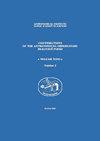接近轨道周期截止点的低质量接触双星的演化
IF 0.2
4区 物理与天体物理
Q4 ASTRONOMY & ASTROPHYSICS
Contributions of the Astronomical Observatory Skalnate Pleso
Pub Date : 2020-04-06
DOI:10.31577/caosp.2020.50.2.461
引用次数: 0
摘要
由于恒星风和磁制动,食双星的演化导致了系统的角动量和质量损失。对太阳附近低温低质量接触双星(lmcb)的观测研究为研究这类系统的大量样本提供了手段。观测到的0.22天的轨道周期截止限制被认为是进化机制的结果,这样的系统在调查系统最终合并之前的非常进化阶段时起到了探测器的作用。这项研究的主要目标是确定这些类型的lmcb的恒星演化轨迹,这可能与蓝离散星和快速旋转恒星的形成有关。本文章由计算机程序翻译,如有差异,请以英文原文为准。
Evolution of low mass contact binaries close to the orbital period cut-off
The evolution of eclipsing binaries leads towards angular momentum and mass loss from the systems, due to stellar wind and magnetic braking. Observational investigations of low-temperature and low-mass contact binaries (or LMCBs) in the solar neighborhood provide the means for studying a large sample of such systems. The observed orbital period cut-off limit of 0.22 days is believed to be a result of evolutionary mechanisms, and such systems act as probes in investigating the very evolved stages of systems before their final coalescence. The main goal of this study is the determination of the stellar evolution tracks of these type of LMCBs, which might be correlated to the formation of blue stragglers and rapidly rotating stars.
求助全文
通过发布文献求助,成功后即可免费获取论文全文。
去求助
来源期刊
CiteScore
1.10
自引率
20.00%
发文量
4
审稿时长
>12 weeks
期刊介绍:
Contributions of the Astronomical Observatory Skalnate Pleso" (CAOSP) is published by the Astronomical Institute of the Slovak Academy of Sciences (SAS). The journal publishes new results of astronomical and astrophysical research, preferentially covering the fields of Interplanetary Matter, Stellar Astrophysics and Solar Physics. We publish regular papers, expert comments and review contributions.

 求助内容:
求助内容: 应助结果提醒方式:
应助结果提醒方式:


